Avro Lancaster B 1 – S for Sugar, 467 Sqn RAAF, preserved Hendon (DAMAGED)
Add to compare1 in stock
£49.00
1 in stock
Corgi Aviation AA32601 was the first 1/72 Lancaster model; an excellent replica of “S for Sugar” of 467 Squadron Royal Australian Air Force, which completed 137 missions over enemy territory and is now preserved on display at the RAF Museum, Hendon. Features opening bomb doors, rotating turrets and moving guns with crew figures, and optional undercarriage positions with stand. Really has to be seen to be appreciated and now extremely hard to find. As with many Corgi models, this first Lancaster is still in by far the best livery.
Length 11.75 inches Wingspan 17 inches
PLEASE NOTE: Model is not perfect; it has been on display and there is evidence of light zinc rot on the upper wing. Box has some very light scuff marks to edges and a small area on the lid where the patina is missing, but typical for the size and age and nothing that badly detracts. Please do not purchase unless you are happy with the above. Even if only purchased for spares this model is worth the price
Avros chief designer, Roy Chadwick knew that the twin engined Manchester was a good aircraft. Designed to cope with the stresses of dive bombing and to carry torpedoes, it had immense strength and a large, partition free bomb bay. But it was dogged by the under developed Rolls Royce Vulture engine, whose construction (bolting two 12 cylinder engines round a common crankshaft) led to catastrophic unreliability.
Faced with the ignominious Air Ministry instruction to build Halifax bombers instead, Chadwick worked feverishly in association with Rolls Royce and produced what was arguably the greatest bomber of WWII. With a ceiling of up to 24,000 feet and an eventual load carrying ability greater than its entire weight, the Lanc was not only prized by the Brass hats, but much loved by its crews for its ability to get them out of trouble with near fighter agility, yet take off, cruise and land with genteel docility.
From its first operational sortie in March, 1942, some 7,377 aircraft were made, flew 156,000 missions and dropped 608,612 tons of ordnance; that is two thirds of all the bombs dropped by Bomber Command during the war. But there was always a price to be paid. Over 4,000 Lancasters, together with their seven man crews, were lost.
The Lancaster was far from a blunt instrument. That capacious bomb bay allowed Barnes Wallis to design the bouncing Upkeep bomb, the 12,000lb Tallboy and the 22,000lb Grand Slam all of which were specific, tactical weapons. Arguments over the effectiveness of these weapons miss the point; that Bomber Command and its leader, Arthur Harris, would always adopt new technology that would aid precision bombing. Lancasters also played a crucial role in daylight operations before, during and after D-Day and additionally, were the preferred aircraft for the Pathfinder forces and in developing the first effective air-to-ground Radar navigation system; H2S.
| Weight | 3-8 kg |
|---|









